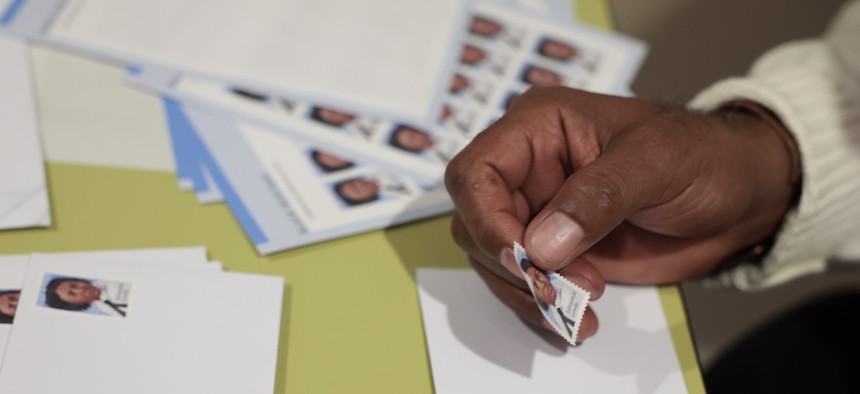
The Edmonia Lewis Forever stamp issued in January 2022 is the 45th stamp in the Black Heritage series. Lewis was the first African American and Native American sculptor to earn international recognition. The price of a stamp will increase to $0.66 in July, the second price hike this year. Anna Moneymaker/Getty Images
USPS Is Planning Another Above-Inflation Rate Increase in July
Prices just went up in January, but the Postal Service is seeking an even larger increase this summer.
The U.S. Postal Service plans to increase the price of a stamp to $0.66 in July, part of a 5.4% overall increase from current First-Class mail rates.
The hike is the full amount authorized under the mailing agency’s rate-setting authority and would mark the latest of several significant increases under Postmaster General Louis DeJoy. USPS said the change was necessary to keep pace with inflation, though DeJoy has previously suggested the increases would continue to allow the Postal Service to reach a financial break-even point.
The Postal Service will also increase rates for packages and marketing mail by 5.4%. Periodicals will see an 8.1% spike.
“As operating expenses fueled by inflation continue to rise and the effects of a previously defective pricing model are still being felt, these price adjustments are needed to provide the Postal Service with much needed revenue to achieve the financial stability sought by its Delivering for America 10-year plan,” USPS said. “The prices of the U.S. Postal Service remain among the most affordable in the world.”
The USPS board of governors has signed off on the price hike, but it must still receive final approval from the Postal Regulatory Commission. The commission allowed for the higher increases in 2020 and DeJoy has tapped into the authority on nearly every allowable occasion, calling them a key part of his plan to allow USPS to find firmer financial footing. Approval of the increases will amount to a simple checking of the math to ensure postal management stayed within the permissible formula.
In addition to higher-than-inflation increases, the rate-raising authority provided by PRC allows the Postal Service to raise its rates twice per year instead of just once. It did so twice in the last year, with First-Class mail jumping by 6.5% in July 2022 and 4.2% in January 2023.
Last year, DeJoy told the mailing industry to be prepared for ongoing, “uncomfortable” rate hikes. The expected $107 billion in financial relief from the Postal Service Reform Act that President Biden signed into law in 2022 would not be enough to make USPS solvent, DeJoy said, as it still anticipates between $60 billion and $70 billion in long-term losses. Still, the Postal Service ended fiscal 2022 with about $22 billion in liquidity.
USPS is so far losing significantly more money in fiscal 2023 than it anticipated. It was $2.1 billion in the red as of February, exceeding its expectations by 75%. Despite the recent price increases, revenue for the year has dropped by about 1%. That was driven by volume declines of 7%, which critics have said DeJoy has accelerated by increasing rates—while slowing down some mail delivery—and driving large-scale mailers to exit the system. USPS has seen slight revenue growth in both First-Class mail and packages for the year, as higher rates have offset declining use. But significant losses in marketing mail and other categories have offset those gains.
The new rate system the Postal Regulatory Commission established in 2020 created a complicated formula for setting prices derived from factors including inflation, declining mail use and retiree costs. The Postal Service historically only raised its rates in line with inflation, but since 2021 DeJoy has repeatedly used the new authority to increase prices at a far faster clip.
DeJoy vowed as part of his 10-year business plan to use his authority to raise rates above inflation "judiciously," but predicted USPS would generate between $35 billion and $52 billion by 2031 by raising prices. He has acknowledged that would drive some mail out of the system, but said he was only slightly speeding up the timeline for an inevitable drop off.
Several industry groups have asked the postal regulator to revoke the new rate-setting authority, noting the Postal Service’s financial outlook has changed dramatically since President Biden signed a reform measure into law. That petition is currently pending before the commission, though last year PRC told lawmakers in a 628-page review that the system was “working as intended.” The groups previously sought to block the new authority from taking effect, but they lost the case in federal court. Rep. Gerry Connolly, D-Va., previously introduced legislation to revoke the new authority and task PRC with developing a replacement one.







